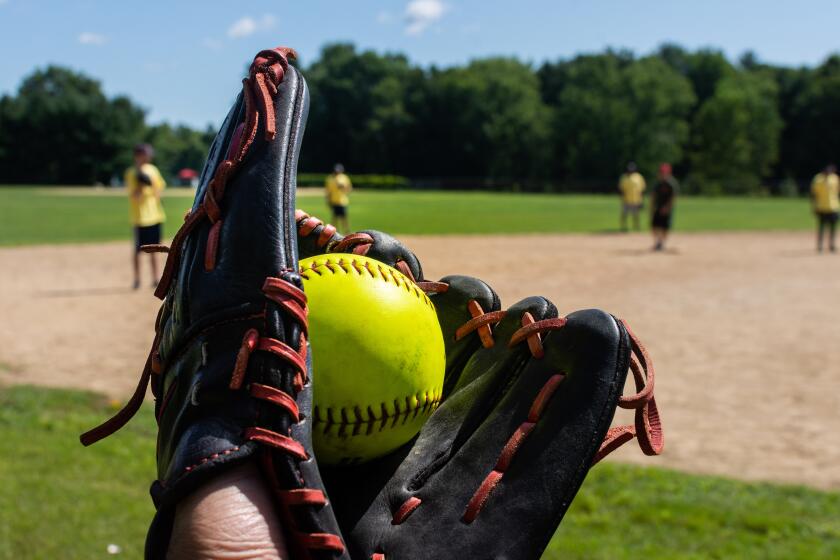This Time, Steels Makes the Most of His Chance : Outfielder Plays His Way Onto the Roster by Leading Team with .400 Average
- Share via
SAN DIEGO — In recent springs, James Steels felt like a guy who had an invitation to the prom but knew he would be stood up.
“James, you have a chance to make the ballclub this year,” he was told each spring.
“Yeah, sure,” Steels would say to himself. “I’ve heard this line before.”
Each spring, Steels’ initial reaction would prove correct. He would come to camp and find that there were no openings in the Padre outfield.
This spring, though, things turned out differently for Steels, 25. He has earned a spot on the Padre opening-day roster by batting a team-high .400 this spring.
Manager Larry Bowa and General Manager Jack McKeon had told him during the winter that he would have a legitimate chance to make the team. Steels may have heard the story before, but he believed it this time because he trusted Bowa, his manager at Las Vegas last season.
There was a word of caution from the Padres: Rookies Benito Santiago, Joey Cora and Stanley Jefferson would make the team unless they flopped in spring training. By contrast, Steels had to prove himself.
The Padres like the way Steels bats (.307 at Las Vegas last season), runs the bases (35 stolen bases) and plays defense (19 assists in the outfield.)
But for the first time in his career, the left-handed hitter will be a reserve this season.
“I know he wants to play every day,” Bowa said. “I told him he’ll have to mentally accept his role. It’s hard. It was either that or Triple-A. Ask him that question and it’s no doubt what he’d want to do.”
There was no doubt.
“I could go down and play every day,” Steels said. “I’d rather get my time in here. If I have to sit around here, I’ll sit around. If I do sit, I can learn from the veterans.”
Already this spring, Steels has learned one thing: If he would quit striking out so much, he’d be a much better hitter. In 45 at-bats this spring, he has struck out nine times.
“He’s going to get his strikeouts down because he has been a good contact hitter,” said Deacon Jones, Padre batting coach. “Remember, we’re talking of a young man who is used to playing every day. He has to adjust to this role of filling in. When called on, we’ll need him to walk, drive in a run or move a runner. I think he has the ability to do that. If someone goes down, we wouldn’t be afraid to run him out there every day.”
Steels, whose father, Robert, played semipro ball, played first base at Santa Maria High School. He also played quarterback on his high school football team. Baseball and football were his life.
“Sports are what kept me in school,” he said. “They made me keep my grades up to play. If it wasn’t for sports, I don’t know how much I would have liked school. By playing sports, I hardly missed a day of school. I made sure I was there every day for practice.”
The Padres drafted Steels out of high school in the eighth round in 1979. But instead of signing with the Padres, Steels decided to play quarterback at Hancock Community College.
One season of college football helped him decide on baseball.
“I couldn’t handle football any more after that year,” Steels said. “I got beat up too much. At Hancock, I dislocated my shoulder two times. After that, I said ‘Forget it.’ ”
He signed with the Padres before the 1980 season, and they made him an outfielder because of his speed.
His first stop was at Class-A Reno, where he hit .302. He suffered a knee injury that season that he says may actually have saved his career.
“I was real homesick,” Steels said. “I didn’t know how long I could put up with it. When I hurt my knee, it saved me. I got to go home for a month and a half.”
When Steels returned to Reno that summer, he was cured of homesickness.
For the next six seasons, Steels played in the minor leagues. His most productive season was in 1984, when he hit .340 to lead the Texas League.
The next spring, he came to camp hoping to make the Padres. He was sent to Las Vegas, where he batted .261.
He returned to Las Vegas in 1986, where he batted .307 and caught Bowa’s attention.
Luckily for Steels, Bowa was named Padre manager shortly after the 1986 season.
“I had always wondered what was going on,” Steels said. “I wondered why I had never gotten a better look before. I had no control over it. I did what management said. I still had fun playing baseball. I thought, if they didn’t want me here, maybe somebody else would want me.”
But the Padres wanted Steels this season--as long as he proved himself worthy in spring training.
“I knew I had to hit well this spring,” Steels said. “They weren’t going to give a job to me. I had to do something to open their eyes.”
A .400 spring average has done just that.
More to Read
Go beyond the scoreboard
Get the latest on L.A.'s teams in the daily Sports Report newsletter.
You may occasionally receive promotional content from the Los Angeles Times.










